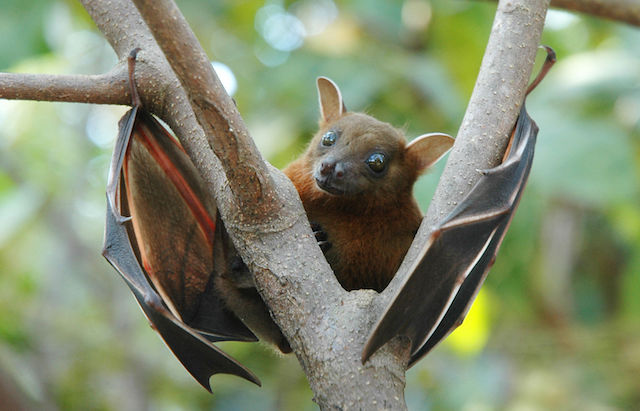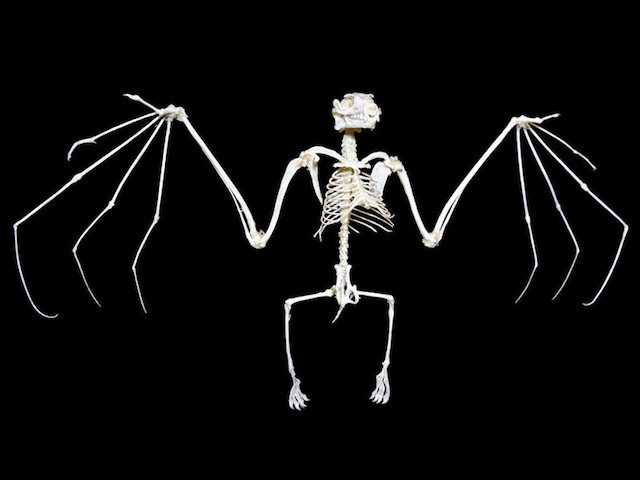
fruit bat, from wikimedia
Many people liked my Several Short Sentences About… Jellyfish, so I thought I’d reprise the idea with a list of interesting things about bats, which are mammals… sort of like us:
- Bats evolved about 60-100 million years ago; by 50 million years ago (when the closest relative to a human was Plesiadapis, a lemur-like creature) bats already looked and behaved much as they do today.
- Of the 5000 known species of mammals, 1200 of them are bats; they range in size from thumbnail size (roosting in bamboo stalks; the smallest mammals on earth) to a six foot wingspan, and range in weight from less than that of a dime to 3 pounds for the 5′ long “flying fox”.
- Macrobats (one of the two major groups of bats) are much closer to humans in their DNA than they are to mice, or to birds, or to microbats, the other major group; macrobats are genetically so similar to primates that they were originally classed as a branch of primates.
- Bats have larger brains than most birds and other creatures of their size; that’s due to an evolutionary anomaly: bat bodies evolved to be progressively smaller to better fit ecological niches, while their brains stayed the same size.
- They are very intelligent, and very curious creatures, exploring and interacting with novel objects and situations much as ravens do (a scientist in Panama has trained bats to follow the sound of heavy metal music, but ignore other genres, to receive a food reward).
- They have excellent memories and ability to differentiate: They can distinguish between poisonous and non-poisonous frogs by their calls, between individual humans by their breath, and discern individuals among their thousands (or millions) of roost-mates.
- They are highly social: They regroup in their roosts daily to be closer to ‘friends’, favour matrilineal relatives, demonstrate sharing and other altruistic behaviours, and rub noses as greetings and to confirm identities.
- They can fly up to 60mph, and because of their flexible wings — that are so complex aerodynamics engineers have been unable to adapt them to human travel technologies — they are many times more agile in flight than birds or insects.
- They are the only flying mammals (“flying squirrels” can only glide).
- Some bats can hover like hummingbirds, and others can run up to 5mph on the ground.
- Their wings are adaptations of mammalian hands, not arms, as the primate-like skeleton below illustrates.

bat skeleton, from wikimedia
- Bats’ wing “struts” are very close anatomically to human finger bones, and wing membranes are very similar to the skin between our fingers (their genus name chiroptera means “hand-wing).
- Their wings are covered in the same ultra-sensitive cells as human fingertips, each topped with a tiny hair (1/100th the size of a human hair) that registers air flow and turbulence.
- Bats’ echolocation is quite different in mechanism (though not in fundamental principles) from that of whales and dolphins.
- We still know relatively little about how bats’ echolocation works; it involves pitches well beyond human hearing range as well as many different forms of clicks, buzzes and trills.
- Most of a bat’s echolocation calls are to navigate deftly around solid objects at high speeds, rather than to track prey.
- The sonar and radar used in human society (and many technologies developed to help humans with impaired sight) are based directly on the study of bats’, though bat echolocation is vastly more complex, subtle, organic and sensitive than the human adaptations.
- Bats’ echolocation calls can reach 140 db (equivalent to a jet engine), the loudest of any flying creature, and average 60 db. Humans are oblivious to the constant barrage of loud noises in most natural places because they’re beyond our range of hearing.
- Bats contract their ear muscles so their own calls don’t damage their hearing; they can “tune” their ears to filter out all but the specific range of sound frequencies they are focused on.
- A large part of their brains are devoted to “making sense” of the ultrasonic signals; they “create the world” with sound as much as we do with vision. It’s how they “see”, in far more detail than we can.
- Their echolocation can detect objects smaller than the width of a human hair, over large distances, even if both they and the object are moving, and they can also detect the object’s texture, velocity, direction and acceleration.
- Some moths fight back against bat echolocation with clicks that effectively jam bats’ signals, but some bats have evolved a counter-strategy of “whispering”at low volumes and different frequencies when near these moths.
- Bats use both FM (less distance but more precision) and CF (constant frequency, longer-range but less precise) echolocation signals.
- Most megabats are vegans (fruits and nectars); most microbats are principally insectivores and nectar-eaters (only 3 of 1200, exclusive to Latin America, drink blood — generally by lapping a teaspoonful from a sleeping cow using an anticoagulant in their saliva).
- Over 500 species of plants, and almost all tropical rainforest species, depend heavily on bats for pollination; without bat pollination there would be no tequila, bananas, mangoes, chocolate, or avocados, and 80 fewer important medicines.
- Bats prefer the subtlest smelling plants, and gather nectar at night, the opposite of bees; this extends the pollination period for plants to round-the-clock, and to more plants.
- Bats use their very long tongues to gather pollen, which, when not in use, are often rolled up under their rib cages (they don’t fit in their mouths).
- They are the largest consumer of june beetles and stink bugs, and can easily consume 1000 mosquitos in an hour.
- They drink water in flight by skimming the surface of lakes, rivers and ponds, mouths ajar.
- Bats are major human disease vectors, including for very serious diseases like ebola, SARS, MERSA, and all the hemorrhagic fevers, though they almost never contract any of these diseases (they are just carriers); bats (like dogs and cats) are susceptible to rabies, but it’s rare.
- Trying to find out why this is, scientists have discovered that because they have gathered in huge groups for millions of years, and because of the enormous metabolic stresses of bats’ exhausting flight on their DNA, bats have of necessity evolved astonishingly strong immune systems, including almost complete immunity to cancers, immune system deficiency and hyperactivity disorders, and the ability to auto-repair almost all damaged/deformed DNA.
- As a result, their average lifespan-to-body-weight ratio is completely out of line with (four times) that of all other mammals — many bats live more than 40 years.
- This is what makes white-nose syndrome so confounding — it has decimated up to 90% of North American bat populations; white-nose syndrome is a soil fungus from Europe that European bats are immune to but North & South American bats have never been exposed to and hence have no immunity against.
- One bat colony in Austin Texas houses 1.5 million bats, more than the human population of the city; a rural Texas bat cave has 20 million bats living in it.
- Some bats migrate long distances, some hibernate for months, some go into a torpor state (breathing reduced to <1 breath/minute; heart rate reduced from 250 to 10 bpm) for part of some or every day, some do all of the above, and some do none of the above.
- In Texas ‘bat guano’ was once the largest state export, used as fertilizer and to make gunpowder.
- Most bats (especially megabats) can see very well, including ultraviolet waves we can’t see, and have cat-like night vision.
- Bats are meticulous self-groomers; perhaps they have to stay “aerodynamically clean” to keep flying straight.
- Not all bats live in caves; some craft sophisticated “tents” out of large leaves in tropical rainforests, or live in hollows, abandoned buildings, or natural or human-made bat-houses.
- Baby bats “babble” with each other to learn how to vocalize; listening to their parents they craft highly complex personal songs that are used to identify themselves and to woo mates.
- Bats’ social vocalizations are complex and precise: A recent study discovered that their calls convey the identity of the individual caller and recipient, the context and purpose/objective of the communication, the intended action, and a tonal intonation that distinguishes the recipient as either a trusted “friend” or an anxiety-producing “foe”.
- Bats navigate location using an unfathomable combination of magnetic resonance, attuned to the earth’s magnetic core, and light sensitivity, attuned to the shifting location of sunrise and sunset.
- They can sleep upside down because their arteries have evolved one-way valves to prevent blood flowing in the wrong direction and cutting off circulation.
- While they’re more than agile enough to avoid wind turbines, many die from collapsed lungs due to flying quickly through areas near wind turbines with extreme air pressure gradients; likewise they can’t fly at high altitudes like most birds can.
- Females have only one “pup” a year; they fly with the pup clinging to them using evolved ‘false nipples’ that offer no milk but excellent traction.
- Female bats are somehow able to keep the sperm separate from their egg up to six months until it’s the best time to conceive for survival of the pup.
- Bats are fond of oral sex (both ways), licking their own genitals, homosexual grooming, and sex just for fun (or as the scientific study put it, in bats “female sexual motivation appears to be independent of ovarian hormones”).
[OK, I admit, some of the above sentences are not by any means “short”. The title is an homage to NYT nature writer Verlyn Klinkenborg’s brilliant essay & book “Several Short Sentences About Writing”.]
Since we want every blog post to be somewhat actionable as well as entertaining and informative, here’s a great source of information on how to build your own bat house.
Why should you build a bat house? The bats you attract will:
- pollinate your plants,
- enrich your soil,
- spread your seeds, and
- reduce the number of mosquitos and moths you have to contend with
And with a house of their own they’ll stay out of your house and leave you alone so you don’t have to worry about #30. But take care not to touch them, get medical attention in the highly unlikely case you get bitten by one, and use a mask if you’re cleaning guano out of a bat or bird house or attic (to minimize the risk of histoplasmosis).
It is such arrogance to be searching for “intelligent life” on other planets, when it is clear it is swirling around us, everywhere, in the oceans, in the forests, and in the skies above us, all of which our “intelligent” species is despoiling and desolating.
But alas, we cannot hear.





This was great. I love bats and everyone thinksIi’m batty (pun intended). They get such a bad rap, thanks for listing all the positive things about them..